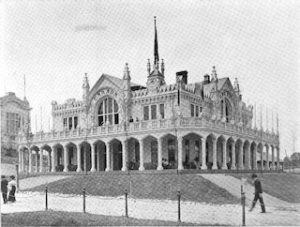The night of October 29, 1998 was a particularly horrible night for the citizens of Tegucigalpa, Honduras. Bridges, hospitals, factories, and prisons were demolished.1 During a period of thirty-six hours Hurricane Mitch poured into the city 25 inches of rain, causing soil saturation with water, bringing about catastrophic landslides. The rain also brought flooding to neighborhoods adjacent to creeks and rivers that customarily have small amounts of water flowing. This flooding ravaged roads and houses, and cut off electric power to most parts of the city.2

People had trouble seeking shelter from the hurricane because navigation around the city was limited. Streets were flooded and bridges were down throughout the city. Hospitals were rapidly filled, but they did not have the necessary conditions to attend to people’s needs because water sources were contaminated, and in certain hospitals, the buildings themselves were affected directly by the flooding as well.3
Five days before Mitch’s arrival, Tegucigalpa was a completely different city. Its citizens could not imagine how their homes and streets, and hospitals and parks, would be affected by the hurricane that was forming on October 24, 1998. Two thousand miles southwest of Jamaica, the tropical storm Mitch became Hurricane Mitch. This 124-mile-diameter beast traveled throughout the Caribbean, passing by the Panamanian coast and then to the Honduran coast where it halted to unleash chaos for day after day. On October 26 it reached its maximum strength, reaching wind speeds of 177 mph, while it hovered off the Honduran coast. On October 29, it hit the Honduran mainland as a Category 4 hurricane, with massive amounts of rain in a short period of time. In two days, Honduras received between twenty-five and thirty times the expected amount of rain for the month of October. As a consequence, Tegucigalpa began to flood because rivers accumulated more water than they could carry, and they began to overflow. Throughout this hilly city, the soil was also over-saturated with water, so landslides occurred frequently.2
The casualties of this terrible catastrophe were 5,657 people, and it left 8,058 missing people and 12,275 injured. Additionally about 250,000 persons were left homeless. The damages to infrastructure reached $3.8 billion. During the following two years, all of the international financial aid that the country received was solely destined to reconstructing the 70% of the national highway system that was affected, including the 92 bridges that were either damaged or completely destroyed. Almost one out of every four classrooms of the public schools were destroyed, and for the ones that remained, it was hard to find teachers, because a great number of teachers were themselves reconstructing their lives by the side of their families. Water conducts were affected and failed to provide clean water to most Tegucigalpan citizens’ homes and to public and private hospitals too.3

Many citizens claimed that the government was not supporting them in the reconstruction of the country, because they did not receive direct help in the form of work or money directly from the government. Instead, the government destined the financial aid they were receiving to reconstruct the most important roads to enable transportation. Once transportation became available, the plan turned to boosting the economy through agricultural production.6
This catastrophic event considerably affected Honduras, and specially Tegucigalpa, because of the great amount of damage it caused to the infrastructure of the country, and because of all the human lives taken and affected by it.
- Jeff Boyer, “Mitch in Honduras,” NACLA Report on the Americas XXXIII, no. 2 (September/October 1999): 36. ↵
- William Smith, “Hurricane Mitch and Honduras: An illustration of population vulnerability,” International Journal of Health System and Disaster Management 1, no. 1 (2013): 54. ↵
- William Smith, ” Hurricane Mitch and Honduras: An illustration of population vulnerability,” International Journal of Health System and Disaster Management 1, no. 1 (2013): 54. ↵
- William Smith, “Hurricane Mitch and Honduras: An illustration of population vulnerability,” International Journal of Health System and Disaster Management 1, no. 1 (2013): 54. ↵
- William Smith, ” Hurricane Mitch and Honduras: An illustration of population vulnerability,” International Journal of Health System and Disaster Management 1, no. 1 (2013): 54. ↵
- Jeff Boyer, “Mitch in Honduras,” NACLA Report on the Americas XXXIII, no. 2 (September/October 1999): 37. ↵



46 comments
Vivian Urrutia
I am from Tegucigalpa, Honduras and I can confirm that Hurricane Mitch is still a Regretful event for the Honduran people. Even though, I have heard stories before about how my parents managed to survive through the hurricane, it was breathtaking to read about the serious damages the hurricane cost to my city. I liked the picture you chose to use in your article because the destroyed bridge still maintains itself in that condition and has always been a reminder all the tragedy that happened in 1998.
Juan Asfura
As a Honduran myself I can say this is one of the worst things that has happen to our country. I was born in 2002 but my parents always tell me stories about the horrors they had to face and how thousands of people lost their home because of the hurricane. On October 2020 we had 2 consecutive hurricanes which left our people on the streets and the economy was left destroyed with these 2 hurricanes and covid 19. As a small country we are trying to get back on our feet but Im sure we will make it out again.
Sharriah Martinez
I was born in 1998. I had never heard about this hurricane. I have alot of friends from st marys who are from Honduras and have friends and family over there. It was sad to know how much destruction was done to this beautiful land. It was sad to hear so many homes, and lives were lost. This earth quake was a life changing catastrophe. I am sure today they still feel some connection and loss, repercussions of this event.
Bictor Martinez
I cannot imagine what it must felt like being in this disastrous hurricane for 36 hours then having to go outside and see your community gone. The infrastructures were not built to withhold such a powerful hurricane and for that, most of the building had been destroyed. I hope that if a hurricane does happen to hit again, they are more than ready with the type of infrastructure they rebuilt their buildings with.
Marina Castro
Great article! The Hurricane Mitch definitely created great destruction in Honduras. The fact that not many were prepared for the amount of strength the hurricane was coming with, made the matters worse. Sadly, so many lives and homes were lost during this disaster. It took a long time for the Honduran people to recover from the catastrophe and to move on with their lives.
Lilliana Canales
Honduras is the country that my dad is from and when hurricane Harvey happened, Mitch was the talk of the house. Tegucigalpa changed drastically after the disaster and many families had to flee, as you mentioned. Fortunately, Tegucigalpa is has regained its tourist attracting site once more.
Diego Aguilera
Although a short article, still great and displayed wonderful detail. Ive actually been to Honduras and it looked nothing like the pictures but of course this was in 2016. Its always crazy to see how a place or city can come back from a tragic event like this as I saw Houston for myself come back or at least make multiple attempts to after the hurricane that hit them. I feel sorry and natural disasters are truly dangerous and should be controlled as best possible.
Rylie Kieny
Being from Texas I have heard a lot about hurricane Harvey along with other large hurricanes that have effected the United States. This article does a good job bringing to light a catastophic hurricane outside the boarders of the US. I think we sometimes forget these tragadies happen in many other places around the world where they do not get the same aid we do. I also liked how the article highlighted effects of the hurricane that many people may not consider. It explained how teachers may not come to work because they are now having to deal with their own issues surrounding the hurricane. People don’t always see everything that follows a tragic event such as this.
Johnanthony Hernandez
Interesting article, with the recent large hurricanes that have made landfall in the past few years we seem to forget the ones that don’t directly affect us. It has always astonished me how devastating hurricanes can be, and at the Category 4 the devastation that it inflicted on the Hondurans is devastating. With Honduras beginning to raise its GDP back up, I can only imagine how difficult it must have been for the country to get back on its feet if it wasn’t for the international financial aid that it received.
Jacob Johnson
I found this article to brief, but well written. I would, however, like clarification on whether 5,657 casualties are also apart of the 8,058 missing persons, or not. I feel that the government of Honduras made a smart decision by first focusing their efforts on reconstructing the roads and highways as that would’ve made other reconstruction projects, both private and public, easier. Looking back on the matter now it is really surprising the level of devastation that Honduras had to endure and overcome, but then again it was nearly twenty years ago and the world including Honduras has come a long way since then. Though saying that we’ve recently endured similar catastrophes (Harvey) and we did not fare much better now then Tegucigalpa did back in 1998, so perhaps (to some extent) history repeats itself?